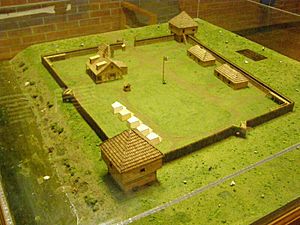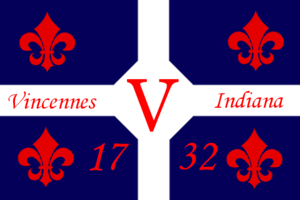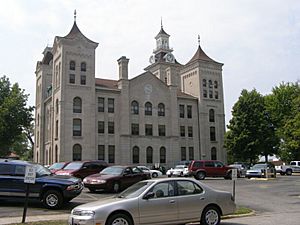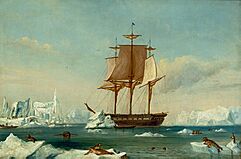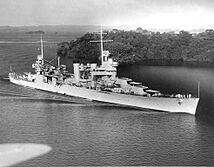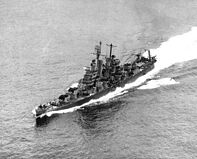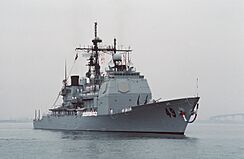Vincennes, Indiana facts for kids
Quick facts for kids
Vincennes, Indiana
|
||
|---|---|---|
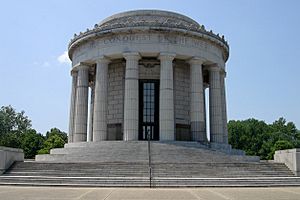
The George Rogers Clark National Historical Park Rotunda
|
||
|
||

Location of Vincennes in Knox County, Indiana
|
||
| Country | United States | |
| State | Indiana | |
| County | Knox | |
| Township | Vincennes | |
| Named for | François-Marie Bissot, Sieur de Vincennes | |
| Area | ||
| • Total | 7.48 sq mi (19.37 km2) | |
| • Land | 7.41 sq mi (19.19 km2) | |
| • Water | 0.07 sq mi (0.18 km2) 0.94% | |
| Elevation | 420 ft (130 m) | |
| Population
(2020)
|
||
| • Total | 16,759 | |
| • Density | 2,261.67/sq mi (873.19/km2) | |
| Time zone | UTC-5 (EST) | |
| • Summer (DST) | UTC-4 (EDT) | |
| ZIP Code |
47591
|
|
| Area code(s) | 812 and 930 | |
| FIPS code | 18-79208 | |
| GNIS feature ID | 2397143 | |
Vincennes is a city in Knox County, Indiana, United States. It is the county seat, meaning it's where the county government is located. The city sits on the Wabash River in the southwestern part of Indiana. It's about halfway between the cities of Evansville and Terre Haute.
Vincennes was started in 1732 by French fur traders. One of them was François-Marie Bissot, Sieur de Vincennes, who the city is named after. It is the oldest place in Indiana where Europeans have lived continuously. It was also the capital of the Indiana Territory for a long time. Vincennes is one of the oldest settlements west of the Appalachian Mountains. In 2020, about 16,759 people lived there.
Contents
History of Vincennes
The area around Vincennes was home to different groups of Native Americans for thousands of years. During the Woodland period, some of these people used local hills as burial sites. Two well-known examples are Sugar Loaf Mound and Pyramid Mound. Later, groups like the Shawnee, Wabash, and Miami tribe lived here.
The first European settlers were French. Vincennes began as part of the French colony called Illinois Country, which was part of New France. Later, it became part of the Louisiana colony. After France lost the French and Indian War (which was part of the Seven Years' War), they gave up land east of the Mississippi River to the British. This included Vincennes.
Once the British took control, Vincennes was linked to the Province of Quebec. After the American Revolutionary War, it became part of Illinois County in Virginia. Then it was part of Knox County in the Northwest Territory. Later, it was included in the Indiana Territory. Vincennes was the capital of the Indiana Territory from 1800 until 1813. The government then moved to Corydon.
French Settlement and Trading
The first trading post on the Wabash River was set up by Sieur Juchereau in 1702. He and 34 Canadiens started the post to trade for buffalo hides with Native Americans. The exact spot of this post is not known. However, because the Buffalo Trace (an old trail) crosses the Wabash at Vincennes, many think it was there. The post was successful, but it was abandoned after Juchereau died. The French-Canadian settlers moved to Mobile, which was then the capital of Louisiana.
Vincennes is the oldest European town in Indiana. It was officially started in 1732 as a second French fur trading post. The Compagnie des Indes (a French trading company) asked a French officer, François-Marie Bissot, Sieur de Vincennes, to build a post. This was to stop local Native American groups from trading with the English. Vincennes built the new post where the Wabash and White rivers meet, and where the Buffalo Trace crossed.
Vincennes had lived with his father among the Miami tribe. He convinced the Piankeshaw people to create a village near his trading post. He also encouraged Canadian settlers to move there. But the Wabash post was very far away. It was hard for Vincennes to get trade supplies from Louisiana for the Native American nations. English traders were also trying to get the Native Americans to trade with them. In 1745, the border between the French colonies of Louisiana and Canada was set. It ran between Fort Ouiatenon (near modern-day Lafayette, Indiana) and Vincennes.
In 1736, during a French war with the Chickasaw nation, Vincennes was captured. He was burned at the stake near the modern-day town of Fulton, Mississippi. His settlement on the Wabash was then renamed Poste Vincennes in his honor.
After Vincennes died, Jean-Baptiste Le Moyne, Sieur de Bienville, the governor of Louisiana, appointed Louis Groston de Saint-Ange de Bellerive to lead Poste Vincennes. As French colonists moved north and south, American colonists to the east kept moving west. British traders also took away many Native American traders from the Canadiens. This competition grew in the Ohio Country and led to the French and Indian War in 1754.
British Control
On February 10, 1763, New France was given to the British after the French and Indian War. Vincennes then came under British rule. British officer John Ramsey arrived in Vincennes in 1766. He counted the people, improved the fort, and renamed it Fort Sackville. The population grew quickly, creating a mix of Native Americans, Canadian settlers, and British traders.
Vincennes was far from the main British power centers. In 1770 and 1772, Thomas Gage, the British commander in North America, heard that people in Vincennes were causing trouble against the British government. They were also encouraging Native American tribes to attack British traders. The Colonial Secretary, the Earl of Hillsborough, ordered the people to be removed from Vincennes. Gage waited, and the residents said they were "peaceful settlers" who were just farming the land the King of France gave them. The problem was solved by Lord Dartmouth, who replaced Hillsborough. He told Gage that the residents were British subjects with rights. So, Gage did not take action against them.
In 1778, people at Poste Vincennes learned about the alliance between France and the American Second Continental Congress. They decided to support the American revolutionaries. The local Piankeshaw tribe, led by Chief Young Tobacco, also joined them.
Revolutionary War Battle

Lieutenant Colonel George Rogers Clark, Captain Leonard Helm, and others planned to capture the French forts that the British had taken over. After Clark captured Kaskaskia, British Lieutenant Governor Henry Hamilton sent British soldiers from Detroit to Fort Vincennes. He also helped rebuild the fort.
The Italian merchant and Patriot Francis Vigo found Clark and told him about the British at the fort. Vigo helped the Patriots by getting war supplies from the Spanish. He also worked as a secret agent for the Patriots. Clark gathered enough men to outnumber the British. He planned a surprise attack on Fort Vincennes in the middle of winter. This was a very difficult time for armies to attack because of illness, lack of food, and high floodwaters. The Patriots won the Battle of Vincennes on February 23–24, 1779. Hamilton thought of Vincennes as "a refuge for debtors and Vagabonds from Canada." George Rogers Clark recaptured Fort Sackville in the Battle of Vincennes without losing a single soldier.
After the Revolution
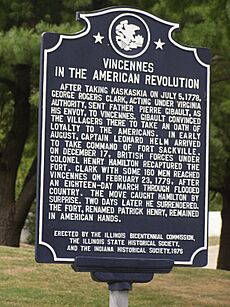
Even though the Americans controlled Vincennes, it took years for peace to truly settle. In 1786, Captain John Hardin led a group of Kentucky soldiers across the Ohio River. They destroyed a friendly Piankeshaw town near Vincennes. This led to many attacks and counter-attacks between the Wabash Native Americans and American settlers.
On July 15, 1786, the Wabash people arrived in 47 war canoes at Vincennes. They wanted to push the Americans back to Kentucky. The Native Americans warned the Canadians beforehand that they would not be harmed. But the Canadians warned the Americans. The Americans quickly got supplies for Fort Patrick Henry and waited out the siege. One American was killed and four were wounded. The war party left after destroying the Americans' farms.
In response, Virginia Governor Patrick Henry allowed George Rogers Clark to gather Kentucky soldiers. They planned an expedition against the warring tribes. General Clark gathered 1,000 soldiers and left Clarksville on September 9, 1786. They followed the Buffalo Trace. The soldiers spent ten days in Vincennes before marching north along the Wabash. However, hundreds of men left the group. Clark soon had to return to Vincennes without any fighting.
Clark left 150 men to help defend Vincennes. But this group soon became lawless. The people of Vincennes asked Congress for help. Secretary of War Henry Knox sent Colonel Josiah Harmar and the First American Regiment to restore order. The Kentucky soldiers fled Vincennes when the U.S. Regulars arrived.
Colonel Harmar left 100 soldiers under Major Jean François Hamtramck. He told them to build a fort called Fort Knox. Vincennes remained a lonely town. It was hard to get supplies because it was deep inside Native American territory. Traveling safely to and from Vincennes meant going with a large, armed group. This was true whether traveling by land or by the Wabash River.
On September 30, 1790, Major Hamtramck led 350 men from Vincennes. They went as far north as the Vermillion River. They wanted to fight some of the Native American villages that had been at war with Vincennes. However, the Kickapoo tracked the group. They made sure every village along the way was empty before the Americans arrived. Hamtramck destroyed some empty villages, but he did not fight any war parties. Because soldiers from Kentucky were leaving, Hamtramck returned to Vincennes. The trip did not seriously harm Vincennes' enemies. But it did distract some of the Wabash villages while Josiah Harmar, now a General, led a much larger expedition through Ohio country towards Kekionga.
Land Claims and Growth
The first land claims by people living in Vincennes were based on a sale by Native Americans to the French in 1742. This land was a large area of 1.6 million acres, known as the Vincennes Tract. It was a rectangular area next to the Wabash River at Vincennes. France gave this land to Britain in 1763 after the French and Indian War. Later, the United States Supreme Court said these land sales were not valid.
However, George Rogers Clark gained this land for the United States in 1779. The Land Act of 1796 recognized its borders. The Vincennes Donation Lands were part of a law in 1791. This law gave land to the people and settlers in Vincennes and the Illinois country.
By 1798, Vincennes had grown to 2,500 people. It was no longer just a trading post. It was a busy city.
Elihu Stout started the first newspaper in the Indiana Territory in 1804 in Vincennes. The Indiana Gazette first came out on July 31, 1804. A fire destroyed the printing presses in 1806. But Stout started the newspaper again as the Western Sun in 1807.
Vincennes was the first capital of the Indiana Territory. It remained the capital until May 1, 1813, when it was moved to Corydon.
In 1826, about 500 Shawnee Indians (men, women, and children) passed through Vincennes. They were moving from their land at Wapaghkonetta to the Mississippi River. The famous Indian prophet and a son of the great Tecumseh were with them.
Ending Forced Labor
Forced labor was practiced in the 16th century when Indiana was part of New France. Both the French and Native Americans used it. When the area became part of the Northwest Territory, forced labor was banned by the Northwest Ordinance of 1787. However, forced labor and indentured servitude (where someone works for a period to pay off a debt) still continued.
People who held others in forced labor found a way around the law. They said the rule did not apply to African Americans who were already enslaved in the state. In 1816, the Constitution of Indiana made forced labor illegal. It stated that "there shall be neither slavery nor involuntary servitude in this state."
Polly Strong, a woman who was enslaved in Vincennes, went to court to argue that she should be free. She lost her case in a lower court. But she won at the Indiana Supreme Court on July 22, 1820, and she became free.
In another important case, Mary Clark v. G.W. Johnston, Mary Clark was a former enslaved person who was made an indentured servant in Vincennes. She won her freedom on November 6, 1821. The Indiana Supreme Court ruled that forced servitude went against the state's 1816 Constitution. This was a very important case for indentured servants and helped bring an end to forced labor in Indiana.
City Flag
The flag for the city of Vincennes, Indiana, is not official, but it is used around the city. It has a special "V" shape. It also has four fleurs-de-lis, which are symbols of the city's French background. These four symbols also represent that the city has existed in four centuries: the 18th, 19th, 20th, and 21st, since it was founded in 1732. The flag looks a bit like the flag of Indianapolis. Vincennes' flag is more square and has a diamond shape in the middle instead of a circle. This diamond shape represents the layout of Vincennes. White stripes coming out from the diamond show Vincennes' role in settling the frontier, as it was a meeting point for several important pioneer trails.
Geography and Climate
Vincennes is located on the banks of the Wabash River. This is at the western edge of Knox County and also the western edge of the state of Indiana. Illinois is across the river to the west. The city is about 100 miles (160 km) southwest of Indianapolis. U.S. Route 41 goes through the city from north to south. U.S. Route 50 passes just north of the city from east to west.
According to the 2010 census, Vincennes covers a total area of about 7.478 square miles (19.37 km2). Most of this, about 7.41 square miles (19.19 km2), is land. A small part, about 0.068 square miles (0.18 km2), is water.
Weather in Vincennes
Vincennes has a humid subtropical climate. This means it has hot summers and cool winters. There is often heavy rainfall throughout much of the year. On average, there are about 53 days each year when the temperature reaches 90 °F (32 °C) or higher. There are also about 101 days when the temperature drops to 32 °F (0 °C) or lower.
In January, the average high temperature is 36.3 °F (2.4 °C), and the average low is 18.3 °F (−7.6 °C). In July, the average high is 87.7 °F (30.9 °C), and the average low is 64.8 °F (18.2 °C). The highest temperature ever recorded was 104 °F (40 °C) on June 26, 1988. The lowest temperature ever recorded was −26 °F (−32 °C) on January 19, 1994.
The city gets about 44.43 inches (112.9 cm) of rain each year. It rains on about 105 days each year. The most rain in one year was 60.08 inches (152.6 cm) in 1990. The least rain was 36.02 inches (91.5 cm) in 1988. The most rain in one month was 11.18 inches (28.4 cm) in November 1985. The most rain in 24 hours was 5.07 inches (12.9 cm).
Vincennes gets about 5.8 inches (15 cm) of snow each year. It snows on only about 2.6 days. The snowiest winter was 1989–90, when 16.4 inches (42 cm) of snow fell. The most snow in one month was 8.5 inches (22 cm) in December 1990. The most snow in 24 hours was 8.0 inches (20 cm) on March 24, 1990.
Population Information
| Historical population | |||
|---|---|---|---|
| Census | Pop. | %± | |
| 1850 | 2,070 | — | |
| 1860 | 3,960 | 91.3% | |
| 1870 | 5,440 | 37.4% | |
| 1880 | 7,680 | 41.2% | |
| 1890 | 8,853 | 15.3% | |
| 1900 | 10,249 | 15.8% | |
| 1910 | 14,895 | 45.3% | |
| 1920 | 17,160 | 15.2% | |
| 1930 | 17,564 | 2.4% | |
| 1940 | 18,228 | 3.8% | |
| 1950 | 18,831 | 3.3% | |
| 1960 | 18,046 | −4.2% | |
| 1970 | 19,867 | 10.1% | |
| 1980 | 20,857 | 5.0% | |
| 1990 | 19,859 | −4.8% | |
| 2000 | 18,701 | −5.8% | |
| 2010 | 18,423 | −1.5% | |
| 2020 | 16,759 | −9.0% | |
| U.S. Decennial Census | |||
2010 Census Data
In 2010, there were 18,423 people living in Vincennes. There were 7,407 households and 4,108 families. The city had about 2,486.2 inhabitants per square mile (959.9/km2) people per square mile. There were 8,259 homes, with about 1,114.6 per square mile (430.3/km2) homes per square mile.
Most of the people in the city were White (91.9%). There were also African American (4.7%), Native American (0.3%), Asian (0.7%), and people from other races (0.7%). About 1.7% of people were from two or more races. Hispanic or Latino people made up 1.9% of the population.
Out of the 7,407 households, 26.6% had children under 18 living with them. About 36.8% were married couples living together. 14.1% had a female head of household with no husband present. 4.5% had a male head of household with no wife present. And 44.5% were not families. About 36.0% of all households were made up of single people. 14.1% had someone living alone who was 65 years old or older. The average household had 2.19 people, and the average family had 2.83 people.
The average age in the city was 33 years. About 19.2% of residents were under 18. 20.8% were between 18 and 24. 21.4% were from 25 to 44. 23.6% were from 45 to 64. And 15% were 65 years old or older. The city's population was 50.3% male and 49.7% female.
Education in Vincennes
Public Schools
- South Knox Elementary School
- Tecumseh – Harrison Elementary
- Franklin Elementary
- Vigo Elementary
- Riley Elementary
- Washington Elementary (closed in May 2010)
- South Knox Middle-Highschool
- Clark Middle School
- Lincoln High School
Religious Schools
- Flaget Elementary (Kindergarten to 5th grade)
- Vincennes Rivet High School (6th to 12th grade)
Other Private Schools
- Southwestern Indiana Youth Village (4th to 12th grade)
Colleges and Universities
- Vincennes University was started in 1801 as Jefferson Academy. It is the oldest college in Indiana.
- Purdue Polytechnic Institute has a campus in Vincennes. It works with Vincennes University.
Media
Television
- WVUT PBS (Channel 22) – 22.1 / 22.2 / 22.3 – from Vincennes University
Radio
- 91.1 FM WVUB "Blazer 91-1" – from Vincennes University
- 92.1 FM WZDM "Wisdom 92-1" – from The Original Company
- 96.7 FM WFML
- 1450 AM WAOV – from The Original Company
Newspaper
- Vincennes Sun-Commercial
Legacy
The Revolutionary War battle at Vincennes was featured in the 1901 novel Alice of Old Vincennes by Maurice Thompson. Four ships have also been named USS Vincennes to honor this battle and the city.
Notable People
Many interesting people have connections to Vincennes:
- Bruce Barmes (1929–2014), a baseball player for the Washington Senators.
- Clint Barmes (born 1979), a baseball player for the San Diego Padres.
- David Carter, a retired football player who played center and guard for the Houston Oilers.
- Henry Dodge (1782–1867), a U.S. senator from Wisconsin.
- Mike Eskew, former chairman and CEO of UPS.
- James Freeman Gilbert, a geophysicist.
- William Henry Harrison (1773–1841), who was the Indiana Territorial Governor and later the 9th President of the United States.
- Jane Jarvis, (1915–2010), an organist for the New York Mets and a jazz musician.
- Buck Jones (1891–1942), an actor who starred in silent films and movies from the 1930s.
- Alvy Moore (1921–1997), an actor.
- Curtis Painter (born 1985), an football player who was a quarterback for Purdue University and several NFL teams.
- Ollie Pickering (1870–1952), the first batter in MLB American League history.
- Red Skelton (1913–1997), a famous comedian and film actor, known for The Red Skelton Show.
- Sarah Knox Taylor (1814–1835), daughter of Zachary Taylor and the first wife of Jefferson Davis.
- Alice Terry (1899–1987), an actress and director in silent films.
Points of Interest
Vincennes has many interesting places to visit:
- George Rogers Clark National Historical Park: This park and memorial honor the war hero George Rogers Clark.
- St. Francis Xavier Cathedral and Library: This is the oldest Catholic church in Indiana and the state's oldest library.
- Grouseland: This was the mansion home of William Henry Harrison, who became the 9th U.S. President.
- Fort Knox II: This fort was the starting point for the Tippecanoe Campaign in 1811. You can see the outline of the fort and take self-guided tours.
- Fort Sackville: One of the historic forts in Vincennes.
- The Indiana Territorial Capitol: This building was the center of government for the Indiana Territory from 1800 to 1813.
- The Indiana Military Museum (indianamilitarymuseum.org): A museum dedicated to military history.
- The Red Skelton Museum of American Comedy: Located on the campus of Vincennes University, this museum has items from the radio, TV, and movie star Red Skelton, who was born in Vincennes.
- Many other places in Vincennes are listed on the National Register of Historic Places. These include Gregg Park, Hack and Simon Office Building, Kimmell Park, Old State Bank, Pyramid Mound, Vincennes Fortnightly Club, and the Vincennes Historic District.
See also
 In Spanish: Vincennes (Indiana) para niños
In Spanish: Vincennes (Indiana) para niños




